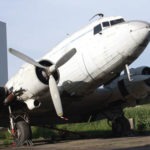History
When the prototype of the DC-3 first flew on the 17th of December 1935, it immediately revolutionised air travel. The DC-3 was safer, more comfortable and faster than all of its contemporary competitors. However, it was the Second World War that made the DC-3 (or the C-47, as the military variant is called) the transport with the highest production number in history: in the USA alone, 10.665 aircraft were delivered, with thousands more manufactured under license in the USSR and Japan.
For the whole duration of the Second World War, the DC-3 (or “Dakota”, as it was called by the British) performed a huge variety of tasks, dropping supplies and paratroopers, towing gliders, transporting goods and troops, etc. After the war, General Eisenhower, the allied Commander-in- Chief in Europe, counted the DC-3 among the 4 things that helped the Allies win the war.
In the post-war years, the DC-3 was virtually ubiquitous, with American war-surplus aircraft flooding the civil transport market or being handed over to allied air forces. Even nowadays, many DC-3s are still in use especially in Africa, South America and Asia. Due to its ruggedness, cheap operation and easy maintenance, the DC-3 has outlived several successors.
The French Air Force and Navy used the DC-3 from 1944 to 1971 and 1982 respectively. These aircraft saw service all around the world in the French colonies, and especially during the war in Indochina.
Characteristics
| Wingspan | 29,1 m |
| Length | 19,4 m |
| Height | 5,18 m |
| Empty weight | 8 t |
| Maximum take off weight | 12,7 t |
| Paload | 3 t or 28pax |
| Speed | 365 km/h |
| Range | 2.575 km |
| Crew | 3 |
| Engine | 2 Pratt & Whitney R1820-92 |
| Serial number | 42-93654 |
Our aircraft
The displayed aircraft, serial number 42-93654 (identifying it as an aircraft ordered by the US government in 1942), started its career as a military C-47 and served in Pakistan. After the war, it flew with several private owners before being abandoned at Toulouse-Blagnac airport. We bought it when it was auctioned off a few years ago. Unfortunately, the aircraft is in dire need of a restoration. Albeit some parts such as the flaps, ailerons and rudder have been dismantled for restoration, no major work has been undertaken until now.
Some photos
360°-Tour
The airplane can be visited during our special events: the Visites Cockpit and theWeek End aux Ailes.
While waiting to be able to visit her “for real”, you can make a virtual tour thanks to Visit Digital.
















